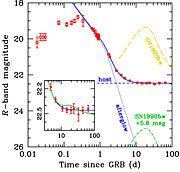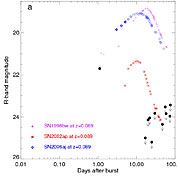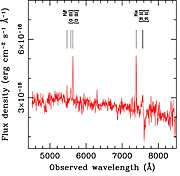Press Release
The Dark Side of Nature: the Crime was Almost Perfect
VLT Uncovers New Way to Form Black Hole
20 December 2006
Nature has again thrown astronomers for a loop. Just when they thought they understood how gamma-ray bursts formed, they have uncovered what appears to be evidence for a new kind of cosmic explosion. These seem to arise when a newly born black hole swallows most of the matter from its doomed parent star.
Gamma-ray bursts (GRBs), the most powerful explosions in the Universe, signal the formation of a new black hole and come in two flavours, long and short ones. In recent years, international efforts have shown that long gamma-ray bursts are linked with the explosive deaths of massive stars.
Last year, observations by different teams - including the GRACE and MISTICI collaborations that use ESO's telescopes - of the afterglows of two short gamma-ray bursts provided the first conclusive evidence that this class of objects most likely originates from the collision of compact objects: neutron stars or black holes.
The newly found gamma-ray bursts, however, do not fit the picture. They instead seem to share the properties of both the long and short classes.
"Some unknown process must be at play, about which we have presently no clue," said Massimo Della Valle of the Osservatorio Astrofisico di Arcetri in Firenze, Italy, lead author of one of the reports published in this week's issue of the journal Nature. "Either it is a new kind of merger which is able to produce long bursts, or a new kind of stellar explosion in which matter can't escape the black hole."
One of the mysterious events went bang on 14 June 2006, hence its name, GRB 060614. The gamma-ray burst lasted 102 seconds and belongs clearly to the category of long GRBs. As it happened in a relatively close-by galaxy, located only 1.6 billion light-years away in the constellation Indus, astronomers worldwide eagerly pointed their telescopes toward it to capture the supernova, watching and waiting as if for a jack-in-the-box to spring open.
The MISTICI collaboration used ESO's Very Large Telescope to follow the burst for 50 days. "Despite our deep monitoring, no rebrightening due to a supernova was seen," said Gianpiero Tagliaferri from the Observatory of Brera, Italy and member of the team. "If a supernova is present, if should at least be 100 times fainter than any other supernova usually associated with a long burst."
The burst exploded in a dwarf galaxy that shows moderate signs of star formation. Thus young, massive stars are present and, at the end of its life one of them could have uttered this long, agonising cry before vanishing into a black hole. "Why did it do so in a dark way, with no sign of a supernova?" asked Guido Chincarini, from the University of Milano-Bicocca, Italy, also member of the team. "A possibility is that a massive black hole formed that did not allow any matter to escape. All the material that is usually ejected in a supernova explosion would then fall back and be swallowed."
The same conclusion was previously reached by another team, who monitored both GRB 060614 and another burst, GRB 060505 (5 May 2006) for 5 and 12 weeks, respectively. For this, they used the ESO VLT and the 1.54-m Danish telescope at La Silla.
GRB 060505 was a faint burst with a duration of 4 seconds, and as such also belongs to the category of long bursts [1].
For GRB 060505, the astronomers could only see the burst in visible light for one night and then it faded away, while for GRB 060614, they could only follow it for four nights after the burst. Thus, if supernovae were associated with these long-bursts, as one would have expected, they must have been about a hundred times fainter than a normal supernova.
"Although both bursts are long, the remarkable conclusion from our monitoring is that there were no supernovae associated with them," said Johan Fynbo from the DARK Cosmology Centre at the Niels Bohr Institute of the Copenhagen University in Denmark, who led the study. "It is a bit like not hearing the thunder from a nearby storm when one could see a very long lasting flash."
For the May burst, the team has obtained deep images in very good observing conditions allowing the exact localisation of the burst in its host galaxy. The host galaxy turns out to be a small spiral galaxy, and the burst occurred in a compact star-forming region in one of the spiral arms of the galaxy. This is strong evidence that the star that made the GRB was massive [2].
"For the 5 May event, we have evidence that it was due to a massive star that died without making a supernova," said Fynbo. "We now have to find out what is the fraction of massive stars that die without us noticing, that is, without producing either a gamma-ray burst or a supernova."
"Whatever the solution to the problem is, it is clear that these new results challenge the commonly accepted scenario, in which long bursts are associated with a bright supernova," said Daniele Malesani, from the International School for Advanced Studies in Trieste, and now also at the DARK Cosmology Centre. "Our hope is to be able to find more of these unconventional bursts. The chase is on!".
Notes
[1] The dividing line between short and long bursts is at 2 seconds. The difference between the two is not only in the duration: short bursts also consist of higher energy photons than the long ones. One may thus infer that the physical origins of the two are different.
[2] Due to their short lifetimes (few million years), massive stars are only found in star-forming regions.
More information
The two gamma-ray bursts were discovered with the NASA/ASI/PPARC Swift satellite, which is dedicated to the discovery of these powerful explosions.
The work presented here is published in the 21 December 2006 issue of the journal Nature: "No supernovae associated with two long-duration gamma-ray bursts", by Johan P. U. Fynbo et al., and "An enigmatic long-lasting gamma-ray burst not accompanied by a bright supernova", by Massimo Della Valle et al. Two other reports about the same events are published in the same issue of Nature.
The Italian-led team - the MISTICI collaboration - is composed of Massimo Della Valle (INAF, Osservatorio Astrofisico di Arcetri, Italy), Guido Chincarini (INAF, Osservatorio Astronomico di Brera & Università degli Studi di Milano-Bicocca, Italy), Nino Panagia (Space Telescope Science Institute, USA), Gianpiero Tagliaferri, Dino Fugazza, Sergio Campana, Stefano Covino, and Paolo D'Avanzo (INAF, Osservatorio Astronomico di Brera, Italy), Daniele Malesani (SISSA/ISAS, Italy and Dark Cosmology Centre, Copenhagen), Vincenzo Testa, L. Angelo Antonelli, Silvia Piranomonte, and Luigi Stella (INAF, Osservatorio Astronomico di Roma, Italy), Vanessa Mangano (INAF/IASF Palermo, Italy), Kevin Hurley (University of California, Berkeley, USA), I. Felix Mirabel (ESO), and Leonardo J. Pellizza (Instituto de Astronomia y Fisica del Espacio).
The Danish-led team is composed of Johan P. U. Fynbo, Darach Watson, Christina C. Thöne, Tamara M. Davis, Jens Hjorth, José Mará Castro Cerón, Brian L. Jensen, Maximilian D. Stritzinger, and Dong Xu (Dark Cosmology Centre, University of Copenhagen, Denmark), Jesper Sollerman (Dark Cosmology Centre and Department of Astronomy, Stockholm University, Sweden), Uffe G. Jørgensen, Tobias C. Hinse, and Kristian G. Woller (Niels Bohr Institute, University of Copenhagen), Joshua S. Bloom, Daniel Kocevski, Daniel Perley (Department of Astronomy, University of California at Berkeley, USA), Páll Jakobsson (Centre for Astrophysics Research, University of Hertfordshire, UK), John F. Graham and Andrew S. Fruchter (Space Telescope Science Institute, Baltimore, USA), David Bersier (Astrophysics Research Institute, Liverpool John Moores University, UK), Lisa Kewley (University of Hawaii, Institute of Astronomy, USA), Arnaud Cassan and Marta Zub (Astronomisches Rechen-Institut, Zentrum für Astronomie der Universität Heidelberg, Germany), Suzanne Foley (School of Physics, University College Dublin, Ireland), Javier Gorosabel (Instituto de Astrofisica de Andalucia, Granada, Spain), Keith D. Horne (SUPA Physics/Astronomy, University of St Andrews, Scotland, UK), Sylvio Klose (Thüringer Landessternwarte Tautenburg, Germany), Jean-Baptiste Marquette (Institut d'Astrophysique de Paris, France), Enrico Ramirez-Ruiz (Institute for Advanced Study, Princeton and Department of Astronomy and Astrophysics, University of California, Santa Cruz, USA), Paul M. Vreeswijk (ESO and Departamento de Astronomia, Universidad de Chile, Santiago, Chile), and Ralph A. M. Wijers (Astronomical Institute 'Anton Pannekoek', University of Amsterdam, The Netherlands).
Contacts
Massimo Della Valle
Osservatorio Astrofisico di Arcetri in Firenze
Firenze, Italy
Tel: +39 (0)55 2752230
Cell: +39 339 4320350
Email: massimo@arcetri.astro.it
Guido Chincarini
Osservatorio Astronomico di Brera (INAF)
Brera, Italy
Tel: +39 39 999 1157
Cell: +39 340 280 3612
Email: guido.chincarini@brera.inaf.it
Johan P. U. Fynbo
Dark Cosmology Centre, Niels Bohr Institute
Copenhagan, Denmark
Tel: +45 3532 5983
Cell: +45 3125 4980
Email: jfynbo@dark-cosmology.dk
Darach Watson
Dark Cosmology Centre, Niels Bohr Institute
Copenhagan, Denmark
Tel: +45 3532 5994
Email: darach@dark-cosmology.dk
About the Release
| Release No.: | eso0649 |
| Legacy ID: | PR 49/06 |
| Name: | Gamma-ray burst, GRB 060505, GRB 060614 |
| Type: | Early Universe : Cosmology : Phenomenon : Gamma Ray Burst |
| Facility: | Very Large Telescope |
| Instruments: | FORS1, FORS2 |
| Science data: | 2006Natur.444.1050D 2006Natur.444.1047F |
Our use of Cookies
We use cookies that are essential for accessing our websites and using our services. We also use cookies to analyse, measure and improve our websites’ performance, to enable content sharing via social media and to display media content hosted on third-party platforms.
ESO Cookies Policy
The European Organisation for Astronomical Research in the Southern Hemisphere (ESO) is the pre-eminent intergovernmental science and technology organisation in astronomy. It carries out an ambitious programme focused on the design, construction and operation of powerful ground-based observing facilities for astronomy.
This Cookies Policy is intended to provide clarity by outlining the cookies used on the ESO public websites, their functions, the options you have for controlling them, and the ways you can contact us for additional details.
What are cookies?
Cookies are small pieces of data stored on your device by websites you visit. They serve various purposes, such as remembering login credentials and preferences and enhance your browsing experience.
Categories of cookies we use
Essential cookies (always active): These cookies are strictly necessary for the proper functioning of our website. Without these cookies, the website cannot operate correctly, and certain services, such as logging in or accessing secure areas, may not be available; because they are essential for the website’s operation, they cannot be disabled.
Functional Cookies: These cookies enhance your browsing experience by enabling additional features and personalization, such as remembering your preferences and settings. While not strictly necessary for the website to function, they improve usability and convenience; these cookies are only placed if you provide your consent.
Analytics cookies: These cookies collect information about how visitors interact with our website, such as which pages are visited most often and how users navigate the site. This data helps us improve website performance, optimize content, and enhance the user experience; these cookies are only placed if you provide your consent. We use the following analytics cookies.
Matomo Cookies:
This website uses Matomo (formerly Piwik), an open source software which enables the statistical analysis of website visits. Matomo uses cookies (text files) which are saved on your computer and which allow us to analyze how you use our website. The website user information generated by the cookies will only be saved on the servers of our IT Department. We use this information to analyze www.eso.org visits and to prepare reports on website activities. These data will not be disclosed to third parties.
On behalf of ESO, Matomo will use this information for the purpose of evaluating your use of the website, compiling reports on website activity and providing other services relating to website activity and internet usage.
Matomo cookies settings:
Additional Third-party cookies on ESO websites: some of our pages display content from external providers, e.g. YouTube.
Such third-party services are outside of ESO control and may, at any time, change their terms of service, use of cookies, etc.
YouTube: Some videos on the ESO website are embedded from ESO’s official YouTube channel. We have enabled YouTube’s privacy-enhanced mode, meaning that no cookies are set unless the user actively clicks on the video to play it. Additionally, in this mode, YouTube does not store any personally identifiable cookie data for embedded video playbacks. For more details, please refer to YouTube’s embedding videos information page.
Cookies can also be classified based on the following elements.
Regarding the domain, there are:
- First-party cookies, set by the website you are currently visiting. They are stored by the same domain that you are browsing and are used to enhance your experience on that site;
- Third-party cookies, set by a domain other than the one you are currently visiting.
As for their duration, cookies can be:
- Browser-session cookies, which are deleted when the user closes the browser;
- Stored cookies, which stay on the user's device for a predetermined period of time.
How to manage cookies
Cookie settings: You can modify your cookie choices for the ESO webpages at any time by clicking on the link Cookie settings at the bottom of any page.
In your browser: If you wish to delete cookies or instruct your browser to delete or block cookies by default, please visit the help pages of your browser:
Please be aware that if you delete or decline cookies, certain functionalities of our website may be not be available and your browsing experience may be affected.
You can set most browsers to prevent any cookies being placed on your device, but you may then have to manually adjust some preferences every time you visit a site/page. And some services and functionalities may not work properly at all (e.g. profile logging-in, shop check out).
Updates to the ESO Cookies Policy
The ESO Cookies Policy may be subject to future updates, which will be made available on this page.
Additional information
For any queries related to cookies, please contact: pdprATesoDOTorg.
As ESO public webpages are managed by our Department of Communication, your questions will be dealt with the support of the said Department.






